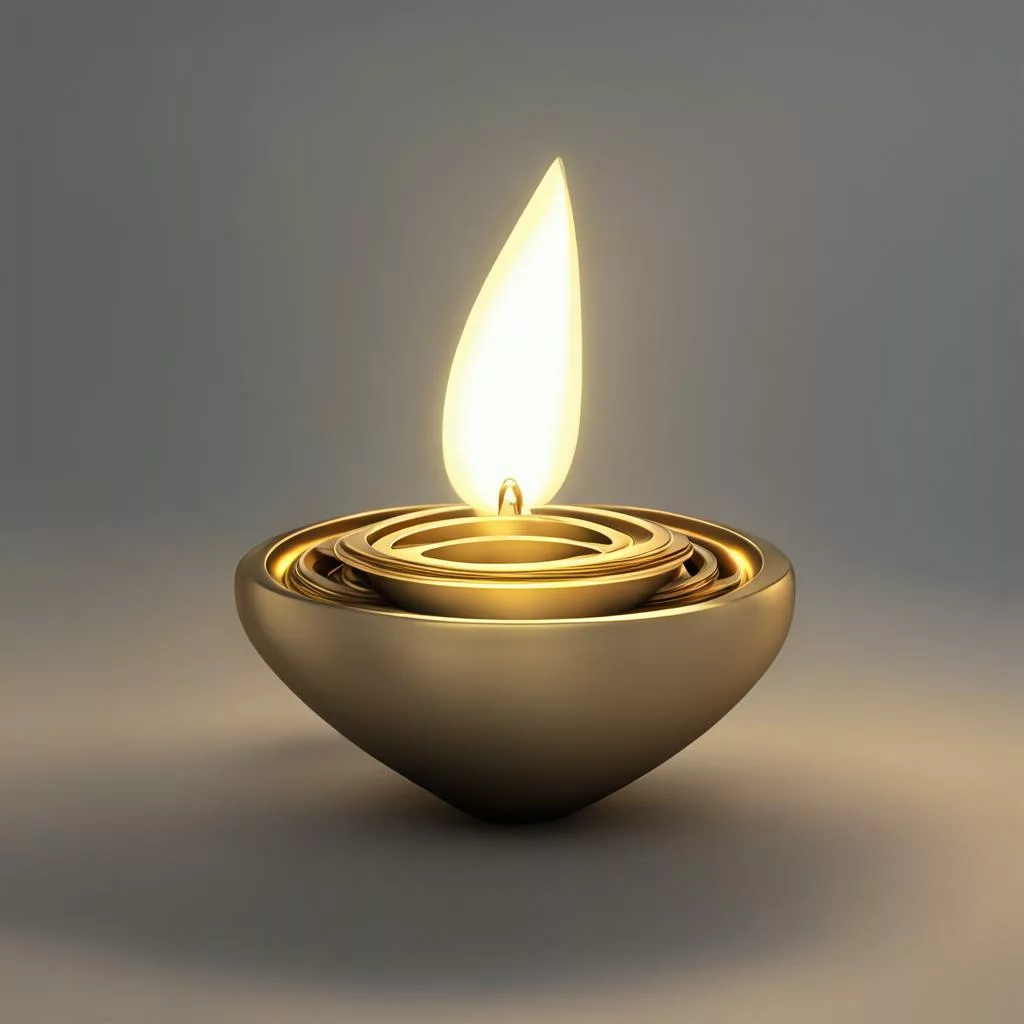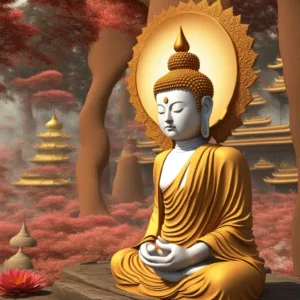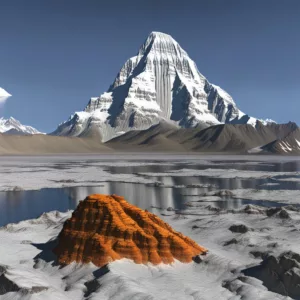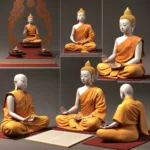
Puja (pooja) is a ritual offering of many symbolic items, both real and visualized. The ritual has many forms, some are entire practices taking up to 10 days or longer. Some retreats are incorporated into longer practices.
Poojas exist to express devotion and generosity towards enlightenment and realized teachers. This expression, even if visualized, increases the mind’s generosity or dana. Dana is a base condition for progress on the path. It is the first of the 6 paramitas. Great generosity equal non-attachment. True non-attachment means seeing emptiness. Thus non-attachment as generosity leads to genuine wisdom.
By offering greatly to sentient beings and buddhas, merit is received in vast quantities. This merit helps one to rapidly progress along the path of Vajrayana.
Key Takeaways
- Puja expresses gratitude: It allows Buddhists to show reverence and appreciation for the Buddha, Dharma, and Sangha.
- Cultivates positive qualities: Making offerings fosters generosity, while the focus and chanting develop concentration.
- Deepens connection: Offering strengthens the practitioner’s bond with the Buddhist path and its core values.
- Source of inspiration: The ritualistic aspects and symbolism of offering rituals inspire practitioners on their spiritual journey.
- Accessible practice: offering rituals can be conducted in grand temples or simple home altars, making it accessible for all Buddhists.
Table of Contents
Puja Related Terms
| Entity | Description | Relationship to pooja |
|---|---|---|
| Purpose | ||
| Siddhi | Practitioners seek meditative powers, especially the 4 karmas of pacifying, enriching, magnetizing and destroying | |
| Expressing Gratitude | Showing reverence and appreciation to the Buddha, Dharma, and Sangha. | |
| Cultivating Generosity | Offering fosters a spirit of detachment and giving. | |
| Merit-Making | Believed to create positive karma (merit) that benefits oneself and others. | |
| Focus and Concentration | The act of offering and chanting helps cultivate focus and concentration. | |
| Deepening Connection | Strengthens the practitioner’s bond with the Buddhist path and its core values. | |
| Elements | Items used in a offering rituals ceremony. | Puja incorporates these symbolic offerings. |
| Flowers | Represent impermanence, beauty, and the blossoming of spiritual qualities. | |
| Incense | Represents devotion, the offering of a pleasing aroma, and transformation. | |
| Water | Represents purity, clarity, and cleansing of the mind and body. | |
| Light | Signifies wisdom, dispelling darkness, and illuminating the path to enlightenment. | |
| Food | Represents sustenance, generosity, and offering the fruits of one’s labor. | |
| Chants and Mantras | Prayers, praises to Buddhas, or mantras for specific purposes. | May be used in certain offering rituals traditions. |
| Types | ||
| Specific Buddhas or Bodhisattvas | Dedicated to seeking blessings or guidance from particular Buddhas or Bodhisattvas. | |
| Personal Well-being | Conducted for health, peace, or overcoming obstacles. | |
| Buddhist Holidays and Festivals | Performed to commemorate important Buddhist occasions. | |
| Performance | Locations where offering rituals can be held. | Puja can be performed in these settings. |
| Temple | A traditional Buddhist place of worship. | |
| Home Altar | A designated space for offering in a practitioner’s home. | |
| Designated Outdoor Space | Any suitable outdoor location chosen for offering rituals. | |
| Monks/Nuns (Optional) | May offer guidance or lead the ceremony. | |
| Lay Buddhists | Devotees who participate in the puja. | |
| Pooja Leader (Optional) | A person who guides the puja ceremony. | May be a monk, nun, or experienced practitioner. |
Puja: A Buddhist Offering of Devotion to accumulate Merit
Offering ceremony, a beautiful and symbolic ritual in Buddhism, expresses devotion and gratitude to the Buddha, Dharma (teachings), and Sangha (community). This post delves into the essence of puja, its various forms, and its significance on the Buddhist path.
Puja Meaning
The word originates from the Sanskrit language, literally translating to “reverence” or “homage.” Within Buddhism, pooja signifies an offering made to express respect, gratitude, and cultivate qualities like generosity and merit-making.
Puja Buddhism
It plays a significant role in various Buddhist traditions. While there are similarities to pooja practices in Hinduism, Buddhist offering rituals focus on offering reverence to the Buddha, Dharma, and Sangha, rather than Hindu deities.
Puja Name, pooja in Hindi, Pooja vs puja
“Puja” is the original Sanskrit term for this ritual. You might also encounter “pooja,” which is a widely used variation with a slightly more modern connotation. Both terms are generally understood to refer to the offering ceremony.
In Hindi, “pooja” translates directly and holds a broader meaning encompassing rituals and offerings in Hinduism, Jainism, and Buddhism.
Elements of Puja
An offering ceremony typically incorporates various symbolic offerings placed on an altar. These offerings may include:
- Flowers: Representing impermanence, beauty, and the blossoming of spiritual qualities.
- Incense: Symbolizing devotion, the offering of a pleasing aroma, and transformation.
- Water: Representing purity, clarity, and cleansing of the mind and body.
- Light: Signifying wisdom, dispelling darkness, and illuminating the path to enlightenment.
- Food: Represents sustenance, generosity, and offering the fruits of one’s labor.
8 Outer Offerings in Tantric Practice
| Offering | Sanskrit Term | Symbolic Meaning |
|---|---|---|
| Drinking Water | Argham | Represents the purification of body and mind, the offering of clarity and cleanliness. |
| Foot Water | Padyam | Cleansing the feet of the dust of samsara. The dakini does not receive Padyam because she is flying in the sky of wisdom, not touching the ground. |
| Flowers | Pushpa (པུཥྤ) | Represents impermanence, beauty, and the blossoming of enlightenment. |
| Incense | Dhūpa (དུག་) | Represents devotion, the offering of a pleasing aroma, and the transformation of negativity. |
| Lamp | Aloke | Represents wisdom, dispelling darkness, and illuminating the path to enlightenment. |
| Perfume | Gandhavya (སྤོས་) | Represents delight, purification of the senses, and the offering of a pleasant fragrance. Senses are pure in themselvs. |
| Food | Naivedya (ལྷག་མ) | Represents sustenance, generosity, and offering the fruits of one’s labor. |
| Music | Gandha (སྒྲ་) | Represents joy, harmony, and the offering of pleasing sounds. |
Inner Offerings
| Offering | Sanskrit | Symbolic Meaning |
|---|---|---|
| Amrita, blessed liquor | अमृत (amṛta) | Purified Desire: Bliss |
| Rakta, blessed tea | rakta (रक्त) | Blood, killing of ego and obscurations, Purified Aggression: clarity |
| Torma, ritual cake | बलिं (balim), approximate meaning | Vajra Ignorance. Ritual cake with many representational meanings. Purifed ignorance: non-thought. |
Other Inner Offerings
Inner Tantric Offerings
| Name | Sanskrit | Symbolic Meaning |
|---|---|---|
| Mirror (sometimes replaced by a clear, still body of water) | Ādarśa (आ दर्शन) | Represents self-reflection, recognizing one’s true nature and impermanence of the ego. |
| Essence of Self (sometimes visualized as white nectar) | Bodhicitta-sara (बोधिचित्तसार) | Represents enlightened mind essence, compassion, and the potential for Buddhahood within. |
| Essence of Consort (sometimes visualized as red nectar) | Shaktisara (शक्तिसार) | Represents wisdom, energy, and the feminine principle. May symbolize transformation of negative emotions like passion into wisdom. |
| Wind (often visualized as a white feather) | Vayu (वायु) | Represents the subtle energy (prana) that flows throughout the body and mind, and the impermanence of all phenomena. |
| Fire (often visualized as a red or orange flame) | Agni (अग्नि) | Represents transformation, purification, burning away negativity and ignorance. |
| Water (often visualized as a white moon disc) | Ap (अप) | Represents purification, clarity of mind, and the foundation for spiritual practice. |
| Earth (often visualized as a yellow square) | Prithvi (पृथ्वी) | Represents stability, groundedness, and the physical body as a foundation for spiritual development. |
| Flower (often visualized as a beautiful, fragrant bloom) | Pushpa (पुष्प) | Represents impermanence, beauty, and the blossoming of spiritual qualities. |
| Incense (often visualized as fragrant smoke rising) | Dhūpa (धूप) | Represents devotion, the offering of a pleasing aroma, and the transformation of negativity. |
Types of Puja
There’s a range of offering rituals practices within Buddhism, depending on the tradition and purpose. Some common examples include:
- offering rituals dedicated to specific Buddhas or Bodhisattvas, seeking blessings or guidance.
- offering rituals for personal well-being, such as health, peace, or overcoming obstacles.
- Ceremonies to commemorate important Buddhist holidays and festivals.
Monlam Offering, Prayer and Light Puja
- Meaning: “Monlam” translates to “Great Prayer Festival.” It’s a large-scale gathering of monks, nuns, and laypeople who come together for prayers, teachings, and offerings.
- Offering Focus: During Monlam, participants offer food, tea, and financial resources to support the monastic community. These offerings are acts of generosity and merit-making, fostering a sense of interdependence and collective practice.
- Benefits: Monlam offerings:
- Support the livelihood of monastics, allowing them to dedicate themselves fully to their spiritual pursuits.
- Create a powerful collective energy of prayer and devotion.
- Provide opportunities for laypeople to participate in a large-scale meritorious activity.
Fire Puja
Fire offerings are typically 10-day retreats, offering substances to the deity of a sadhana practice. The retreat usually is only attended by those who have completed the practice requirements: a number of mantras (1 million recitations often), a number of sessions, time in retreat, or manifest realization of the practice.
Participants seek siddhi, or meditative powers, especially the 4 karmas. There are 2 types: amending the mantra purifies errors made in reciting the mantra during the practice sessions. 4 karmas supplicates the deity to bestow the siddhis or powers.
- Meaning: Fire poojas, also known as Homa rituals, involve offerings made into a specially consecrated fire. Specific materials like clarified butter (ghee), grains, and herbs are offered with chanting and prayers.
- Offering Focus: Unlike Monlam offerings, Fire offerings have specific intentions. These can include:
- Benefits: Fire offerings:
- Offer a powerful method for purification and transformation.
- Allow practitioners to connect with specific qualities or deities through the offerings and mantras.
- Strengthen faith and cultivate a sense of spiritual connection.
- Purification: Removing obstacles, negativity, and karmic debts.
- Healing: Bringing healing for oneself or others, both physical and mental.
- Protection: Seeking protection from harm and negative influences.
- Accomplishment: Manifesting goals aligned with Dharma practice.
How is Puja Performed?
A typical offering rituals ceremony follows a specific order, though variations exist across traditions. Here’s a general outline:
- Preparation: The offering rituals space is set up, offerings are arranged, and participants purify themselves.
- Invocation: Chants or mantras are recited to invite the presence of Buddhas and other enlightened beings.
- Offering: Each offering is presented with a specific mudra (hand gesture) and recitation.
- Prayers and Chanting: Prayers and chants focusing on refuge, gratitude, and dedication are offered.
- Dedication: The merit gained from the offering rituals is dedicated to all beings for their awakening.
Puja Ceremony
Offering ceremonies can be simple or elaborate, depending on the occasion and tradition. The setting can be a temple, a home altar, or a designated outdoor space. Participants may wear traditional clothing, and a puja leader might guide the ceremony.
Puja in English
For those unfamiliar with the term, “puja” can be simply understood as a Buddhist ritual of offering and reverence.
Benefits of Puja
The practice offers numerous benefits on the Buddhist path:
- Cultivates Generosity: Making offerings is a form of giving, fostering a spirit of detachment and generosity.
- Merit-Making: Puja is believed to create positive karma (merit) that benefits oneself and others.
- Focus and Concentration: The act of offering and chanting helps cultivate focus and concentration.
- Deepens Connection: Engaging in offering rituals strengthens the practitioner’s connection with the Buddha, Dharma, and Sangha.
Setting Up a Home Puja
If you’d like to incorporate offering rituals into your Buddhist practice at home, here’s a basic guide:
- Create a Space: Choose a clean and quiet space for your altar.
- Gather Offerings: Start with simple offerings like flowers, water, and a candle.
- Find Resources: There are many online resources and books that provide detailed guidance on conducting offering ceremonies.

May all beings be happy
May all beings be peaceful
May all beings be safe
May all beings awaken to the light of their true nature
May all beings be free








